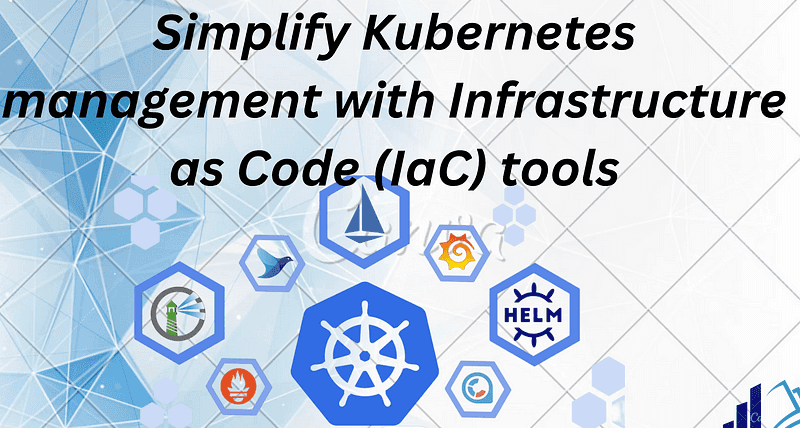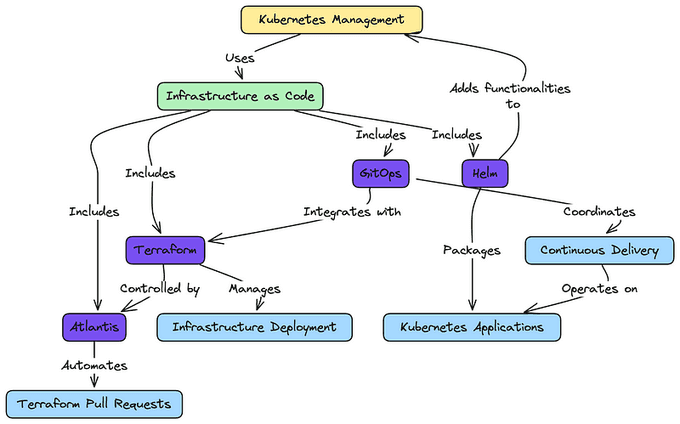
Simplify Kubernetes management with Infrastructure as Code (IaC) tools
Content
How to automate, secure, and scale your Kubernetes infra
🗯 Introduction
Kubernetes is probably the most well-known solution for deploying and managing large-scale containerized applications. But, it can be complex to deploy and manage across different environments and infras.
This is where IaC tools come in. Integrating tools like ArgoCD, Terraform, and Vault can make Kubernetes management more automated, secure, and scalable. In this blog post, we'll explore how using IaC tools can help you manage Kubernetes infrastructure more efficiently.

Kubernetes Management with IaC: A Technical Deep Dive
Managing a Kubernetes cluster efficiently requires a clear automation strategy.
1. Setting Up Your IaC Foundation
Start by creating a Git repository to store all your IaC configurations:
- Use separate directories for Terraform, Kubernetes manifests, and Helm charts.
- Implement a branching strategy (e.g., GitFlow) for managing changes. GitFlow helps in organizing your work with feature branches, release branches, and hotfixes.
- Set up pre-commit hooks to enforce code quality and formatting using tools like pre-commit.
2. Automating Cluster Provisioning with Terraform
Terraform is key for creating and managing your Kubernetes infrastructure:
- Define your cluster using Terraform's Kubernetes provider.
- Use Terraform modules to create reusable components (e.g., VPCs, subnets).
- Implement Terraform workspaces for managing multiple environments (dev, staging, prod).
Example Terraform code snippet:
provider "aws" {
region = "eu-west-1"
}
module "eks_cluster" {
source = "./modules/eks"
cluster_name = "my-cluster"
vpc_id = module.vpc.vpc_id
subnet_ids = module.vpc.private_subnets
node_groups = {
example = {
desired_capacity = 2
max_size = 3
min_size = 1
instance_type = "t2.medium"
}
}
}3. Enhancing Terraform Workflows
Terraform Cloud:
Terraform Cloud provides remote state management, version control, and a collaborative environment for Terraform runs. To use Terraform Cloud:
- Sign up and create an organization on Terraform Cloud.
- Create a workspace for your project.
Configure the remote backend in your Terraform configuration:
terraform {
backend "remote" {
organization = "my-org"
workspaces {
name = "my-workspace"
}
}
}Atlantis:
Atlantis is an open-source tool for automating Terraform workflows through pull requests.
To set up Atlantis:
- Deploy Atlantis in your Kubernetes cluster.
- Configure repository settings to trigger Atlantis on pull requests.
- Define the workflow in the
atlantis.yamlfile:
version: 3
projects:
- name: my-terraform-project
dir: .
workspace: default
autoplan:
when_modified: ["*.tf"]
enabled: trueTerramate:
Terramate enhances Terraform's capabilities by providing a framework for managing configurations at scale. It allows for better modularization and automation.
- Install Terramate by following the installation guide.
- Define stack configurations in your project:
# terramate.hcl
terramate {
# Define global settings
}
stack "prod" {
# Define stack-specific settings
source = "./stacks/prod"
}4. Streamlining Application Deployment with Helm and Helmfile
Helm simplifies package management for Kubernetes:
- Create Helm charts for your applications.
- Use Helmfile to manage multiple Helm releases.
Example of helmfile:
repositories:
- name: prometheus-community
url: https://prometheus-community.github.io/helm-charts
releases:
- name: my-app
namespace: default
chart: ./charts/my-app
values:
- ./values/my-app-values.yaml
- name: prometheus
namespace: monitoring
chart: prometheus-community/prometheus
version: 15.0.0
values:
- ./values/prometheus-values.yaml5. Customizing Deployments with Kustomize
Kustomize allows for environment-specific customizations:
- Create a base configuration for your applications.
- Use overlays to customize for different environments.
Example Kustomize structure:
├── base
│ ├── deployment.yaml
│ ├── service.yaml
│ └── kustomization.yaml
└── overlays
├── dev
│ ├── cpu_limit.yaml
│ └── kustomization.yaml
└── prod
├── replica_count.yaml
└── kustomization.yaml5. Implementing GitOps with ArgoCD
ArgoCD enables continuous deployment from Git repositories:
- Install ArgoCD in your cluster. Follow the official installation guide.
- Define your applications using ArgoCD custom resources.
- Set up automated sync policies for continuous deployment.
Example ArgoCD Application manifest:
apiVersion: argoproj.io/v1alpha1
kind: Application
metadata:
name: my-app
namespace: argocd
spec:
project: default
source:
repoURL: https://github.com/myorg/my-app.git
targetRevision: HEAD
path: kustomize/overlays/prod
destination:
server: https://kubernetes.default.svc
namespace: my-app
syncPolicy:
automated:
prune: true
selfHeal: true6. Securing Secrets with HashiCorp Vault
Vault provides secure secret management:
- Deploy Vault using the official Helm chart.
- Configure Vault to use Kubernetes authentication.
- Use the Vault Secrets Operator to inject secrets into your pods.
Example Vault SecretStore resource:
apiVersion: secrets-store.csi.x-k8s.io/v1
kind: SecretProviderClass
metadata:
name: vault-database
spec:
provider: vault
parameters:
vaultAddress: "http://vault:8200"
roleName: "database-role"
objects: |
- objectName: "db-password"
secretPath: "secret/data/myapp/database"
secretKey: "password"
namespace: my-app
audience: "vault"7. Automating Cluster Add-ons
Use a combination of Helm and ArgoCD to manage cluster add-ons:
- Create an "add-ons" repository with Helm charts for common tools (e.g., Prometheus, Grafana, Cert-Manager).
- Use ArgoCD to deploy and manage these add-ons.
8. Implementing Policy Enforcement with OPA Gatekeeper
Automate policy enforcement across your cluster:
- Install OPA Gatekeeper using Helm. Follow the installation guide.
- Define custom policies using the Rego language.
- Use Gatekeeper constraints to enforce these policies.
Example Gatekeeper constraint:
apiVersion: constraints.gatekeeper.sh/v1beta1
kind: K8sRequiredLabels
metadata:
name: require-team-label
spec:
match:
kinds:
- apiGroups: [""]
kinds: ["Namespace"]
parameters:
labels:
- key: "team"
value: "my-team"9. Automating Backup and Restore with Velero
Implement automated backup and restore processes:
- Install Velero using Helm. Follow the installation guide.
- Set up scheduled backups using Velero's schedule CRD.
- Automate restore processes for disaster recovery.
Example Velero schedule:
apiVersion: velero.io/v1
kind: Schedule
metadata:
name: daily-backup
spec:
schedule: "0 1 * * *"
template:
includedNamespaces:
- "*"
excludedNamespaces:
- "velero"
ttl: 720h0m0sBy implementing these automation strategies, you'll create a scalable and easily manageable Kubernetes environment. This approach reduces manual work, increases consistency, and improves overall cluster security and reliability.
💬 Key Takeaways
Automating Kubernetes infrastructure with IaC and tools like Terraform, Helm, ArgoCD, and Vault enhances efficiency, security, and scalability. Integrating CI/CD, service mesh, monitoring, and policy enforcement tools ensures resilient Kubernetes environments, driving operational excellence and innovation.
🔖 References:🖌️
- https://www.paloaltonetworks.com/cyberpedia/kubernetes-infrastructure-as-code
- https://www.adaptavist.com/blog/kubernetes--automation-and-configuration-explained
- https://www.fairwinds.com/blog/deep-dive-how-to-improve-kubernetes-management-with-iac-tools
- https://vzilla.co.uk/vzilla-blog/using-terraform-iac-to-automate-your-kubernetes-clusters-and-apps
Until next time, つづく 🎉
💡 Thank you for Reading !! 🙌🏻😁📃, see you in the next blog.🤘 Until next time 🎉
🚀 Thank you for sticking up till the end. If you have any questions/feedback regarding this blog feel free to connect with me:
♻️ LinkedIn: https://www.linkedin.com/in/rajhi-saif/
♻️ X/Twitter: https://x.com/rajhisaifeddine
The end ✌🏻
🔰 Keep Learning !! Keep Sharing !! 🔰
📅 Stay updated
Subscribe to our newsletter for more insights on AWS cloud computing and containers.
